What Is the 1962 Jefferson Nickel Made Of?
The 1962 Jefferson nickel is made of 75% copper and 25% nickel. Although, there was a time when nickel was made of 56% copper, 35% silver, and 9% manganese. This happened during the Second World War when copper and nickel became vital metals for winning the war.
Here’s a quick look at the specifications of the 1962 Jefferson nickel:
- Value – 5 cents ($0.05)
- Mass – 5 grams
- Diameter – 21.21 millimeters
- Plain edge.
The US Mint started to issue the nickel coin in 1866. At that time, it was designed and called the shield nickel, which was issued from 1866 to 1883. Other designs follow, which include the V nickel (1883 to 1913) and Buffalo nickel (1913 to 1938).
Finally, in 1938, the Jefferson nickel was made, and ever since, the Jefferson nickel has stood the test of time until now.
The Buffalo nickel, although nice and beautiful in design, was difficult to produce. The reason is that its die can easily break. That’s why, after 25 years of striking the Buffalo nickel, the Mint was eager to change the design.
To start the change, the US Mint announced an open competition in January 1938, which helped the Mint to find a new design for the nickel. The bicentennial birth of Jefferson happened in 1943. Thus, designers thought of having him on the coin and Monticello on the reverse.
A few months later, in 1938, Felix Schlag was chosen as the winner. His design includes the bust of Thomas Jefferson, the third president of the United States. The design closely resembles the Jefferson sculpture of Jean-Antoine Houdon.
Although the obverse design was accepted, Schlag needed to change his design for the reverse after the officials didn’t like how Monticello was portrayed and its lettering style.
The US Mint allows artists to add their initials to the coin. However, due to some misunderstanding, Schlag’s initials were not included, and it would only be added in 1966.
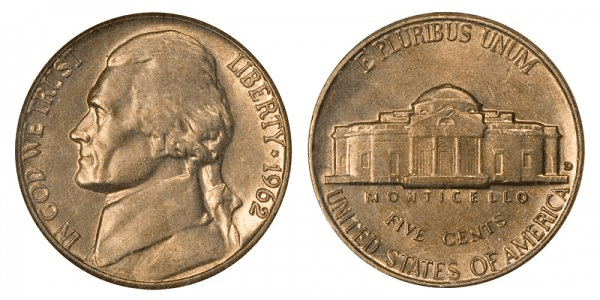
As its name suggests, the 1962 nickel bears the image of Thomas Jefferson facing to the left. On the obverse, inscriptions include IN GOD WE TRUST (arching in front of Jefferson), LIBERTY (arching at the back of Jefferson), and 1962 (year of minting).
On the reverse, you’ll find the Monticello Mansion, designed and built by Jefferson. Inscriptions include E PLURIBUS UNUM (arching on top of the coin), MONTICELLO, FIVE CENTS (arching below the word, Monticello), and UNITED STATES OF AMERICA (arching below the coin).
1962 Jefferson Nickel Varieties
For the 1962 Jefferson nickel, there are three standard varieties. These are the 1962 P Jefferson nickel, 1962 P Jefferson proof nickel, and 1962 D Jefferson nickel.
Before the proof coinage production in the San Francisco Mint, the production of proof coins was done in the Philadelphia Mint. This lasted from 1950 to 1964.
Aside from the standard varieties of the 1962 Jefferson nickels, there are also a few error coins.
Here are the 1962 Jefferson nickel varieties that you should know:
1962 P Jefferson nickel
Edge: Smooth
Mint Mark: No mint mark
Place of minting: Philadelphia
Year of minting: 1962
Face Value: $0.05 (fifty cents)
Price: $0.05 to $10.00 (or more)
Quantity produced: 97,384,000
Designer: Felix Schlag
Composition: 75% copper and 25% nickel
Mass: 5 grams
Diameter: 21.21 mm
Thickness: 1.95 mm
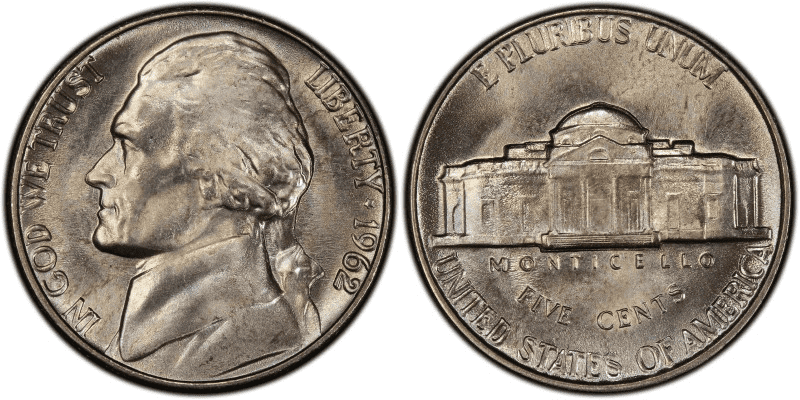
The 1962-P Jefferson nickel was struck in the Philadelphia Mint. There’s no mint mark, and the average price ranges from $0.05 to $10.00.
There are more than 97 million 1962-P Jefferson nickels, making this coin abundant. However, there are fewer of these coins in the mint state. There are even rarer coins with grades up to MS 67.
1962 P Jefferson nickel (proof)
Edge: Smooth
Mint Mark: No mint mark
Place of minting: Philadelphia
Year of minting: 1962
Face Value: $0.05 (fifty cents)
Price: $0.05 to $15.00 (or more)
Quantity produced: 3,218,019
Designer: Felix Schlag
Composition: 75% copper and 25% nickel
Mass: 5 grams
Diameter: 21.21 mm
Thickness: 1.95 mm
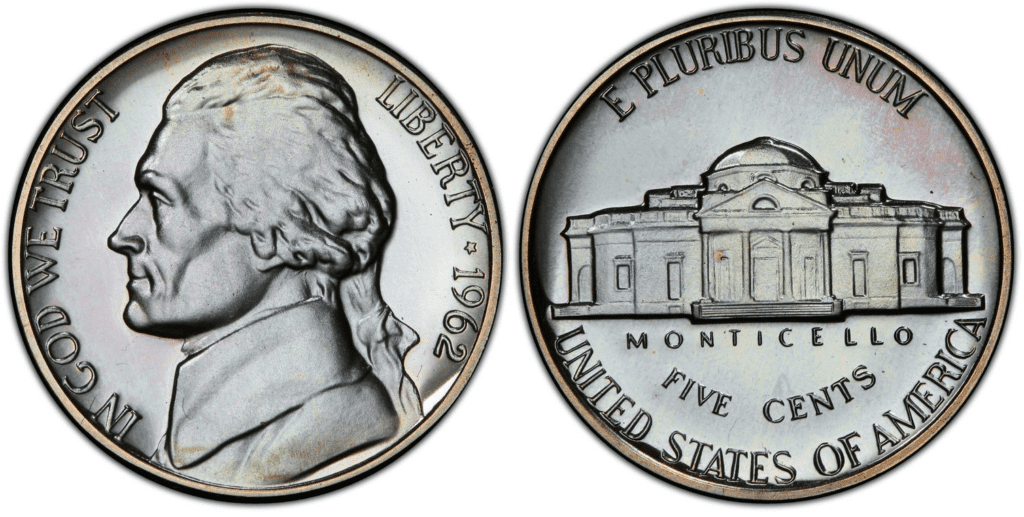
The 1962-P proof Jefferson nickel was also struck in the Philadelphia Mint. The mint mark is absent. The average price ranges from $0.05 to $15.00, which is higher considering that these coins are proof.
You might have noticed the low mintage of this coin. In 1962, the Philadelphia Mint produced more than 3.2 million proof Jefferson nickel. The reason for the low mintage is that proof coins aren’t meant for circulation, but rather they are made for collectors.
Proof coins are more attractive, shinier, and more detailed.
1962 D Jefferson nickel
Edge: Smooth
Mint Mark: D
Place of minting: Denver
Year of minting: 1962
Face Value: $0.05 (fifty cents)
Price: $0.05 to $89.00 (or more)
Quantity produced: 280,195,720
Designer: Felix Schlag
Composition: 75% copper and 25% nickel
Mass: 5 grams
Diameter: 21.21 mm
Thickness: 1.95 mm
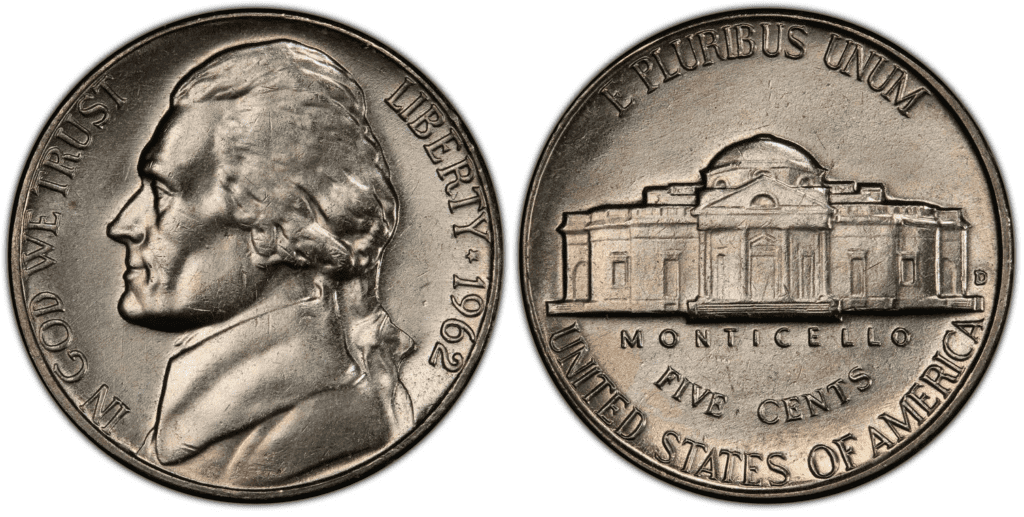
The 1962-D proof Jefferson nickel was struck in the Denver Mint. You’ll find the “D” mint mark on the right side of the Monticello image. The average price ranges from $0.05 to $89.00. The Jefferson nickel coins produced by the Denver Mint are among the most expensive types in this series.
Aside from that, the 1962-D Jefferson nickel has the highest mintage, which is more than 280 million.
List Of 1962 Jefferson Nickel Errors
According to the US Mint officials, there were no specific errors for 1962 Jefferson nickels. However, if there were any errors, they happened sporadically and might not have even been noticed. That’s why you can still find 1962 Jefferson 5-cent coins with errors.
Remember, there are more than 380 million 1962 Jefferson nickels, so it’s inevitable that some will have incorrect strikes. The most common error would be the doubled die obverse (DDO) if the error happened on the obverse and the doubled die reverse (DDR) if the error is on the reverse.
The doubled die error happens when the die strikes the planchet twice. Because of this, you’ll find a slight doubling of the letters, numbers, or other engraved elements.
Sometimes, doubled die errors are difficult to detect. So, special magnification tools are needed. The more pronounced the doubled die error is, the higher its price.
The die may also become worn out. Worn-out dies are supposed to be replaced regularly, but there are coins struck with worn-out dies, and it may lead to not-so-detailed strikes.
Here’s an example:
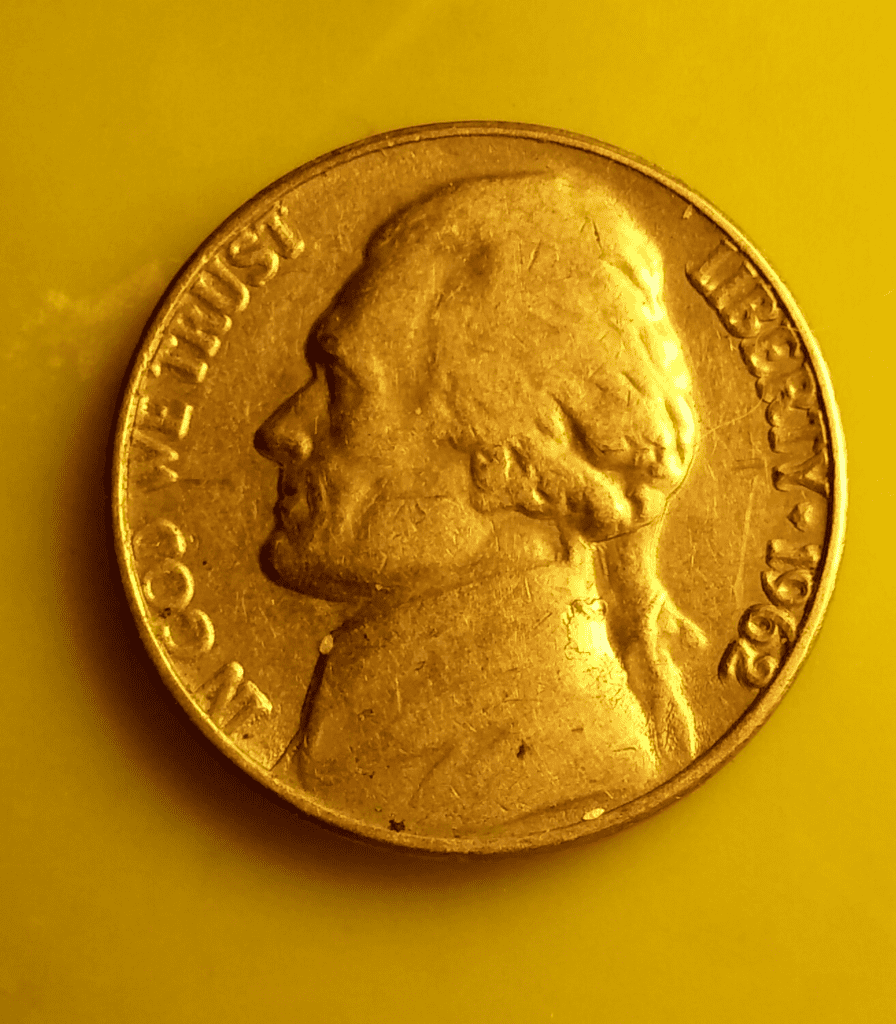
This is what people call the die deterioration doubling (DDD).
Other strike errors may include off-center strikes, weak strikes, and cracked die.
Aside from that, errors may happen in the cutting of planchets. The planchets can be clipped or folded, or they can be too thick or too thin.
Even though error coins are made by mistake, they are among the sought-after coins of collectors because of their uniqueness and rarity.
How Much Is 1962 Jefferson Nickel Worth Today?
Ordinary 1962 Jefferson nickels aren’t that valuable. Its value is the same as its face value, which is $0.05. The melt value is slightly higher at $0.0628.
However, you’ll be surprised to know that some 1962 Jefferson nickels are worth a lot of money, astronomically bigger than their face or melt value. Usually, the more expensive Jefferson nickels come with a higher grade.
To help you get a better idea of the prices, here’s a 1962 Jefferson Nickel values chart:
| Coin | Condition | Grade | Mintage | Value |
| 1962 P Jefferson Nickel | Circulated/mint | Not graded | 97,384,000 | $0.05 to $10.00 |
| 1962 P Jefferson Nickel | Uncirculated/mint | MS-65 | 97,384,000 | $18 to $86 |
| 1962 P Jefferson Nickel | Uncirculated/mint | MS-66 | 97,384,000 | $40 to $284 |
| 1962 P Jefferson Nickel | Uncirculated/mint | MS-67 | 97,384,000 | $1,040 to $4,348 |
| 1962 P Jefferson Nickel (Proof) | Uncirculated/proof | Not graded | 3,075,645 | $0.05 to $15.00 |
| 1962 P Jefferson Nickel (Proof) | Uncirculated/proof | MS-67 | 3,075,645 | $15 to $40 |
| 1962 P Jefferson Nickel (Proof) | Uncirculated/proof | MS-68 | 3,075,645 | $19 to $40 |
| 1962 P Jefferson Nickel (Proof) | Uncirculated/proof | MS-69 | 3,075,645 | $29 to $75 |
| 1962 D Jefferson Nickel | Circulated/mint | Not graded | 280,195,720 | $0.05 to $89.00 |
| 1962 D Jefferson Nickel | Uncirculated/mint | MS-64 | 280,195,720 | $159 to $900 |
| 1962 D Jefferson Nickel | Uncirculated/mint | MS-65 | 280,195,720 | $588 to $3,525 |
| 1962 D Jefferson Nickel | Uncirculated/mint | MS-66 | 280,195,720 | $881 to $1,500 |
As you can see, the 1962 nickel can be worth a lot of money. Just to give you an idea, according to PCGS, one of the leading coin grading service providers today, the most expensive 1962 Jefferson nickel in their record was the “1962 5C MS67+ Full Steps.” It was sold for $21,150 during an auction held by Heritage Auctions in August 2013.
How Does The Grading System Work?
The Sheldon Scale is used by numismatists to provide a numerical value to coins. The Sheldon Scale goes from poor (P-1) to perfect mint state (P-1) (MS-70). Coins were originally evaluated using words to reflect their condition (Good, Fair, Excellent, Etc.). Unfortunately, coin collectors and dealers had different ideas about what each of these terms represent.
Professional numismatists joined together in the 1970s and established CoinGrading standards. These numismatists now assign grades at key places on the seventy-point scale, using the most regularly utilized numeric points in conjunction with the original adjective grade. The following are the most common coin grades:
-
-
- (P-1) Poor – Indistinguishable and probably damaged; if used, must have a date and mintmark; otherwise, rather battered.
- (FR-2) Fair – Nearly smooth, but without the damage that a coin graded Poor often possesses. The coin must have enough detail to be identified.
- (G-4) Fair – Inscriptions have merged into the rims in some areas, and important elements have been mostly erased.
- (VG-8) Very Good- A little weathered, but all of the primary design elements are visible, albeit faintly. There is little if any, central detail left.
- (F-12) Good – The item is very worn, yet the wear is even, and the overall design details stand out clearly. Rims are almost completely isolated from the field.
- (VF-20) Very Fine – Moderately weathered, with some finer features still visible. The motto or all letters of LIBERTY are readable. Both sides of the coin have entire rims that are separated from the field.
- (EF-40) Extremely Fine – Gently used; all gadgets are visible, and the most important ones are bold. The finer details are bold and clear, however, light wear may be seen.
- (AU-50) Uncirculated – Slight evidence of wear on the coin’s design’s high points; may have contact marks; eye appeal should be adequate.
- (AU-58) Uncirculated Choice – Slight traces of wear, no severe contact marks, almost full mint shine, and great eye appeal.
- (MS-60) Mint State Basal – Strictly uncirculated; no indication of wear on the coin’s highest points, but an unsightly coin with reduced luster, visible contact marks, hairlines, and other flaws.
- (MS-63) Mint State Acceptable – Uncirculated, but with contact scratches and nicks, little reduced shine, but otherwise appealing appearance. The strike is weak to average.
- (MS-65) Mint State Choice – Uncirculated with great mint shine, very little contact blemishes, and exceptional eye appeal. The strike is unusually severe.
- (MS-68) Mint State Premium Quality – Uncirculated with superb luster, no obvious contact marks to the naked eye, and exceptional eye appeal. The strike is quick and appealing.
- (MS-69) Almost Perfect Mint State – Uncirculated with perfect brilliance, a sharp and appealing strike, and extremely good eye appeal. A near-perfect coin with minor imperfections in the planchet, strike, and contact markings (seen only under 8x magnification).
- (MS-70) Mint State Perfect – Under 8x magnification, there are no tiny imperfections discernible; the strike is crisp, and the coin is perfectly centered on a beautiful planchet. Rarely seen on a coin, this coin is bright and whole, with original luster and exceptional eye appeal.
-
Where To Buy Or Sell 1962 Jefferson Nickel?
The quickest way to buy or sell 1962 Jefferson nickels would be online. There are a lot of vendors on the Internet who are willing to buy your coins. You can head to online selling platforms such as eBay and Amazon. These websites allow you to both sell and buy 1962 Jefferson nickels.
Just be sure to transact with trusted and reputable people. As you know, the Internet might be a good place to buy or sell coins, but there are people out there who will try to scam you.
Aside from the Internet, you can visit coin shops and antique stores. You can also try auction houses. They are known to sell rare coins.
FAQs
What makes a 1962 Jefferson nickel valuable?
The 1962 Jefferson nickel is made valuable because of its good condition, quality, and rarity. First off, you can check the reverse of the coin, and it should have fully-struck and detailed steps of the Monticello mansion. Next, have the nickel graded. 1962 nickels with grades of at least MS 65 or PR 67 would be so much more valuable compared to ordinary nickels.
How much is a 1962 nickel with no mint mark?
The value of a 1962 nickel with no mint mark can range from $0.05 to a few hundred to a few thousand dollars. The value depends on the condition and rarity of the coin.
What is overstruck on a 1962-D nickel?
The overstruck 1952-D nickel is a nickel coin with an error of doubling engraved elements. This happens when a die strikes a coin already struck by a different die.
Is there a rare 1962 Jefferson nickel?
Yes, there are rare 1962 Jefferson nickels. These nickels are usually the ones with grades of at least MS 66 and MS 67. Only a few coins are known to have these grades.
